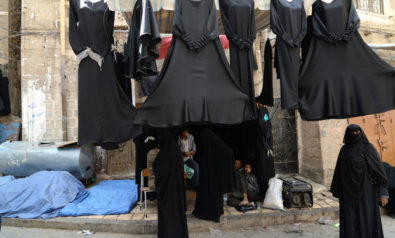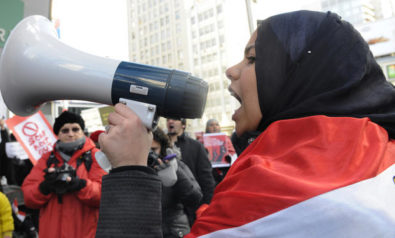Attacks against women in Egypt are part of a new pattern of organized violence.
On the first day of the feast after Ramadan in November 2006, the shocking and disturbing public assault and sexual molestation of women on Egyptian street by tens (some say hundreds) of youth marked a turning point in the perception and realities of sexual harassment in Egypt.
This event, significant because it drew public attention to the growing phenomenon of sexual harassment and assault, prompted outrage from women’s NGOs and some independent media outlets. Given this context, the eighteen days of the 2011 Egyptian Revolution were all the more notable for being without any incident of sexual harassment taking place in Tahrir Square. The brazen assault of CNN journalist Lara Logan on February 11, 2011, was dismissed as an inexplicable exception.
Changes After the Revolution
However, the story of sexual harassment of women in Egypt changed drastically after the revolution and especially after the spread of different religious groups with influence over political, social and legal institutions — formal and informal.
It is my belief that the reasons, nature, objectives and style of sexual harassment before and after the revolution are drastically different. What has been happening for the last 8-12 months is not “sexual harassment” at all; it is contrived, calculated and organized violence against women to exclude us from public life and force us to retire within our homes, stemming from a deep belief that women are the source of “sin” and that our success and participation in public life is the reason behind man’s weakness, lack of ambition and failure. With huge economic challenges and a failing education system, this view is becoming increasingly widespread in Egypt, as uneducated communities seek refuge in narrow interpretations of religious doctrine.
Before the Revolution
As Egyptian society in the weak and corrupt state of Mubarak became less mobile while opportunities for real political and economic engagement became fewer, sexual harassment grew. In many cases it was instigated and carried out by youth who had nothing to lose; unemployed or in humiliating jobs that did not match their education, they were left powerless in an increasingly consumer-driven society. Tempered by restrictions and often unable to marry due to economic constraints, the sexual frustration that simmered in defiance of cultural and religious condemnation of extramarital sex could not be appeased.
The structure and nature of this harassment was different to what women in Egypt are currently experiencing. The majority of cases were individual and in many cases the perpetrators were young adults. Sexual harassment was generally recognized as a phenomenon in the 1990s, but was generally limited to obscene remarks and groping; mob attacks, such as that of 2006, continued to be rare.
Despite growing outrage among groups defending the rights of women, as well as coverage from independent Egyptian media and western publications, the government and state media opted to ignore and undermine the scope and importance of these incidents. Society at large, hindered by patriarchy and a lack of education, generally accepted that political exclusion, unjust distribution of wealth, and feelings of despair had led to this unwelcome status quo.
The early days of the revolution showed a different side of Egypt with very little sexual harassment reported. The few attempted cases were met by immediate community punishment and rejection. This was attributed to youth having regained their identity amid the overall feeling of empowerment. The growth of mass sexual assaults taking place in Tahrir Square and its environs has been explained by youth disengagement with the political process, or the argument that the people who now frequent Tahrir Square are not representative of those who struggled to bring about Mubarak’s downfall, or they not “real Egyptians.”
The Logic Behind Current Attacks
However I, like many other activists, am convinced that the repeated attacks on women after the revolution represent a different phenomenon with specific objectives. The shocking mass assault of women demonstrating on March 8, 2011, for International Women’s Day and a series of high-profile incidents in the following months, which have all had a very similar nature and structure, were only the training and experimentation ground for a new technique of intimidation by specific groups who wanted to see how their behavior would be received. When they found weak responses they began their organized campaign to terrorize and exclude women — not only from Tahrir Square or the streets of Egypt, but from public life.
After the parliamentary elections and the sweeping victory of different Islamic parties (75% of seats), a new trend of harassment appeared with much more far reaching consequences. Contrary to popular opinion, it began not only with physical attacks on women during protests but with calls from Salafi men and others to reinstate old marriage and divorce laws that take away the gains made by women in the last decade. Calls for women to return to their homes and to stay out of public life were echoed even in independent media channels, while the Muslim Brotherhood condemned a UN document on violence against women as leading to the “complete disintegration of society.” The Brotherhood was also opposed to a reference concering the “equal sharing of responsibilities” between men and women in caregiving, parenting, and domestic work.
The significant increase in men wearing, what they claim to be, Islamic dress and growing long beards has been coupled with an increase in women who wear the complete Niqab (with the face and body covered). This was accompanied by ever more cases of unveiled women being assaulted in poor areas, on public transportation, and the streets. Moreover, announcements appeared on social media that vigilantes were forming groups to ensure Islamic laws — especially those pertaining to women’s dress and behavior — were followed, even through the use of violence.
This Islamization of Egyptian society is the result of a warped understanding of religion (which is, at its essence, progressive) that comes mainly from poor education and an inability for critical thought and political, social, and economic disenfranchisement, leading a sizable number of the population to seek solutions to their problems in extreme Islamism. As has happened so many times in history, religion is being used to marginalize, exploit, and terrorize for the sake of power and control.
Government Complicity and Systematization
These calls for vigilante justice were praised by many new Islamist political leaders and members of parliament, some of whom also advocated the enforcement of the Hijab (headscarf). Such overt and covert support from the ruling party and its officials clearly allows those who are orchestrating violent attacks on women to act with impunity. Soon after comments such as these first started to be uttered, reports emerged of attacks on veiled and covered girls by groups of young kids (aged 12-15) in an organized, collective way. Such attacks took place in parks and public areas all over Egypt during the two Eid public holidays in 2012.
Along with this, there have been regular invasions of the women’s only wagon on the underground, and physical and sexual assaults — not only against revolutionary protestors in Tahrir Square, where several gang rapes have been committed — but also in the streets of poor urban and rural areas. The official response has been to deny the incidents or blame the victims for “un-Islamic behavior.”
What is notable about these assaults is that they are systematized and often follow a similar pattern. Usually the victim is surrounded by a group of maybe five to seven men, who form a ring and push her to an isolated area, before defenders have time to stop them. The numbers of assailants might reach tens of males, some of whom use the tactic of pretending to help the woman being assaulted. In some cases, it has been reported that the numbers of attackers have reached the hundreds. Policemen or security officers are rarely seen in these areas, and even if they are there, they often pretend not to see or refuse to help.
The Attackers
The attackers have changed and diversified: groups of adolescent boys in parks and public areas; young adults committing gang rapes against revolutionary female protestors in Tahrir; and sometimes older men in the numerous cases of assault in the women only underground carriages.
Cases of abducting unveiled Christian adolescent women have increased significantly in poor areas but, with the increase in hate crimes against minorities, these actions have been solely attributed to religious tensions and are not seen as attacks targeting women.
These incidents are organized, coordinated, and designed to threaten, not only our dignity and security as women but, our will to participate in the political life of our country as Egyptian citizens. Not only is the trend of blaming the victim employed by Islamist political leaders (male and female) and their media — claiming that women who have been assaulted “asked for it” by going to public places or dressing in an “un-Islamic way” — immoral, it is also illogical. The fact is, a substantial number of the women assaulted have been veiled or wearing the Niqab. Moreover, it is thanks to the participation of all demonstrators – male and female – in the protests that brought down Mubarak that the current regime has been able to ascend to power. Thus, demanding that women retire from public participation in political processes is the height of hypocrisy.
More Than "Just" Sexual Harassment
The emphasis on the sexual nature of these crimes undermines their severity; not because sexual assaults are not serious crimes deserving of punishment but because, all too often, female sexuality is regarded as a commodity in our patriarchal society, and so using sexual intimidation to push us out of public life should be described as what it is: an act of violence and terrorism against a minority that is often not able to fully defend itself. I would even go further and describe it as a hate crime. While some brave women speak out against harassment and assault, many are prevented from doing so by legal and social impediments, religious and cultural conventions, and the threat of further violence.
Terrorizing us in public arenas has not only threatened our ability to be politically active and participate in demonstrating against the current regime, it has also affected our mobility, equal access to safe spaces, and to work far from home or relatively late into the evening. Although this phenomenon may not have stopped some courageous female political activists, especially with the rise of organized movements to counter sexual assaults and secure public spaces, it has nevertheless reduced the number of women who might have joined or wanted to join demonstrations. It has also had a noticeable effect on the landscape of the country, with significant decreases in the number of women who might have joined the informal labor market. These negative effects, which have so far predominantly impacted poor self-employed women, will soon be felt by all of us.
To focus on describing these actions as sexual harassment, and to regard them as isolated incidents or as a trend, opens discussions about issues such as dress codes and morality. These are important topics which we need to address in our fight for women’s rights, for safe streets, and freedom of movement. But we have to be careful that they do not divert our attention from what, I firmly believe, is an organized plot to undermine women and exclude us from public life.
When they attack us, they attack the fabric of Egyptian society and seek to impose an ideology that is narrow-minded and reductive, sweeping aside a culture that has been enriched by women’s participation as equals to our male counterparts. It is imperative that we do not let this happen.
[Note: The views expressed in this article are Dr Iman Bibars’ personal views and not representative of Ashoka, ADEW or any organization with which she is affiliated.]
The views expressed in this article are the author's own and do not necessarily reflect Fair Observer’s editorial policy.
Image: Copyright © Shutterstock. All Rights Reserved
Support Fair Observer
We rely on your support for our independence, diversity and quality.
For more than 10 years, Fair Observer has been free, fair and independent. No billionaire owns us, no advertisers control us. We are a reader-supported nonprofit. Unlike many other publications, we keep our content free for readers regardless of where they live or whether they can afford to pay. We have no paywalls and no ads.
In the post-truth era of fake news, echo chambers and filter bubbles, we publish a plurality of perspectives from around the world. Anyone can publish with us, but everyone goes through a rigorous editorial process. So, you get fact-checked, well-reasoned content instead of noise.
We publish 2,500+ voices from 90+ countries. We also conduct education and training programs
on subjects ranging from digital media and journalism to writing and critical thinking. This
doesn’t come cheap. Servers, editors, trainers and web developers cost
money.
Please consider supporting us on a regular basis as a recurring donor or a
sustaining member.
Will you support FO’s journalism?
We rely on your support for our independence, diversity and quality.












Comment